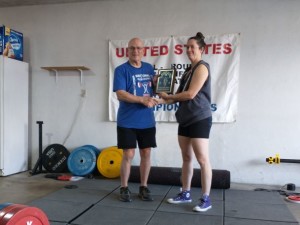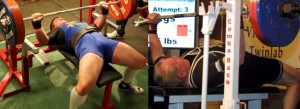By Eric Todd
I would assume that by now most of our readers have read Dan Wagman’s article about the absurdity of the wording change for the bench press rule. While I do take exception with the use of the word absurd, as it seems condescending to those individuals whose only purpose at that time was to do right by the rule, Dan is on to something. The new wording maintaining that the hamstrings must stay in contact with the bench makes the lift undoable for some, which was no one’s intention. As soon as I read the article, I headed to the basement to see if I could complete the lift as it was written, and alas, I could not even come close.
So, how do we go about making this right? We did not want to go a full year with a faulty rule in our rulebook. According to Dan, if we do not amend this “one of two things will happen: 1) meet refs will see that adhering to this rule is impossible for many lifters and will ignore it; 2) lifters like me will simply not perform the bench press and its variations.” Neither of those results is desirable. In looking at our bylaws, Article 6a reads as follows: “The Annual Meeting of the USAWA will be held in conjunction with the National Championships, unless the executive board, by majority vote, decides otherwise.” So, this executive board decided by unanimous vote to reconvene the national meeting virtually with all of the voting members who were present at the meeting in June. These members voted unanimously to correct the wording of this rule.
The corrected rule will read as follows:
The lifter will take a position on the bench with both upper back and buttocks in contact with the bench. The lifter will grip the bar with the palms of both hands facing away from the lifter’s face. The width of the grip must not be more than 32 inches (81 centimeters) between the index fingers. No open grip or thumbless grip is allowed. The bar may be handed to the lifter by a spotter from the support stands, but it must be held motionless momentarily at arm’s length prior to being lowered by the lifter to a motionless position on the chest. The feet must be flat on the floor and not braced against the bench during the lift. The use of plates, blocks, or any similar device under the lifter’s feet is permitted in an effort to achieve firm footing. Any width of feet placement is allowed. No heel or toe rising is allowed during the lift. Once the bar is motionless and under control on the chest, the lifter will receive a command from an official to press. The bar must not be any lower than the base of the pectoral muscle when on the chest. The bar will then be pressed to a position in which the arms are fully extended. During the ascent, the bar may be pressed unevenly, but must not be lowered in any manner. However, the final straightening of the arms must be completely simultaneous. During the ascent, the position of the body on the bench must not change. This includes keeping the buttocks and the head in contact with the bench, and not having any change in hand position on the bar. Once the bar is fully pressed and motionless, the lifter will receive a command from an official to end the lift. The lifter may have assistance by spotters in returning the bar to the support stands.
The only change to the original rule is the addition of the underlined sentence. As you can see, the part requiring hamstrings has been omitted. You can also see that we not only added that plates are allowable, but that anything else used for a similar purpose is allowable. Hopefully that way we don’t hear from members as to how ludicrous it is that we did not include pallets, shoeboxes, or stacks of old vinyl records into the rule, as not everyone has blocks, or plates enough to lift and place their feet on. Since that part of the rule is just in an effort to level the playing field for shorter lifters, the spirit of the rule would dictate whatever article available to allow for that would be acceptable, whether it is blocks, plates, or old, rusty frying pans.
I realize that this procedure was rather unorthodox, but within the rules, and merely done as a way to correct a mistake made by your secretary. I am going to use my inexperience as my excuse here and can only promise to do a better job of having my ducks in a row in the future.




